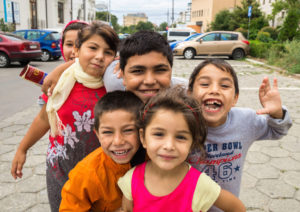The Roma community is the biggest ethnic minority in Europe. In Central and Eastern Europe, it faces deeply entrenched prejudices, and a particularly pervasive discrimination in everyday life, from housing to social and health services, employment, and education. In the area of education, Roma children are victims of segregation at school.
What awaits Hungarian Roma children at the start of their new academic year?
What is School Segregation?
While children across Europe return to school in September, Roma children in Central Europe face different forms of school segregation. The first is intra-school segregation, where Roma children attend regular school but are placed together in separate classrooms, away from other children. The second, inter-school segregation, occurs when Roma children are placed in different schools than other children. This happens either because of the school’s location, closer to Roma settlements or neighborhoods, or because of the biased testing of students before their entry in primary school, which results in Roma children being wrongly diagnosed as mentally disabled and therefore placed in remedial schools or special schools with different curricula.
The first is intra-school segregation, where Roma children attend regular school but are placed together in separate classrooms, away from other children. The second, inter-school segregation, occurs when Roma children are placed in different schools than other children. This happens either because of the school’s location, closer to Roma settlements or neighborhoods, or because of the biased testing of students before their entry in primary school, which results in Roma children being wrongly diagnosed as mentally disabled and therefore placed in remedial schools or special schools with different curricula.
This discrimination against Roma children happens disproportionately in Hungary, where 45% of Roma children in education are placed in segregated schools or classrooms (Rorke, 2016).
What does this mean for Roma Children?
This segregation has several consequences. Roma children may either be discouraged from pursuing secondary or tertiary education, or indeed not  actually reach the necessary level of academic qualification to do so. In addition, they are stigmatized, and this separation can hinder their integration into society, and perpetuate stereotypes and racism. Equal access to education would also give them access to job opportunities and allow them to lift themselves out of poverty, as well as would improve Roma inclusion and participation in society in general.
actually reach the necessary level of academic qualification to do so. In addition, they are stigmatized, and this separation can hinder their integration into society, and perpetuate stereotypes and racism. Equal access to education would also give them access to job opportunities and allow them to lift themselves out of poverty, as well as would improve Roma inclusion and participation in society in general.
From the perspective of mainstream society, heterogeneous classrooms could also benefit other children and boost the performance of all. Contact between disadvantaged and non-disadvantaged children could help improve social skills on both sides, teach empathy and tolerance, and create a classroom environment where children can learn from each other. Later on, Roma inclusion in the workforce is also important for the economy of the country as a whole.
The ECtHR rules against Hungary’s discriminatory practices
Hungary has been warned in the past to modify its policies and to ensure that Roma children have an equal access to education. In 2013, in the case Horvath and Kiss v. Hungary, the European Court  of Human Rights ruled that the two applicants, placed in a special school for mentally disabled children, had been discriminated against, which was in violation of the European Convention on Human Rights (Horváth and Kiss v. Hungary, 2013).
of Human Rights ruled that the two applicants, placed in a special school for mentally disabled children, had been discriminated against, which was in violation of the European Convention on Human Rights (Horváth and Kiss v. Hungary, 2013).
It called on Hungary to take action to remedy its long history of discrimination against Roma children in education, and therefore prevent these situations from arising in the future. Hungary should modify its tests and provide safeguards against discrimination, misdiagnosis, and misplacement of Roma children.
However, in a communication in 2015, it was pointed out that the government had not executed the judgment, and indeed little efforts had been made, to the extent that discrimination against Roma children in education persists today (CCF & ERRC, 2015).
The European Commission also warns Hungary
In May 2016, the European Commission started an infringement procedure against Hungary, requesting the country to end the discrimination of Roma Children in education and to ensure equal access to quality education, in line with the Racial Equality Directive, which prohibits discrimination in education on racial and ethnic grounds (European Union, 2000).
But with the lack of reaction from the Hungarian government, how much can Roma children really hope for in the future?
Written by: Salomé Guibreteau Proofread by: Joséphine Dodd |
Chance for Children Foundation & European Roma Rights Centre. (2015, November 30). Rule 9 Communication from the Chance for Children Foundation (CFCF) and the European Roma Rights Centre (ERRC) in the Case of Horváth and Kiss Against Hungary (Application No. 11146/11) under Rule 9.2 of the Rules of the Committee of Ministers. Retrieved September 13, 2016, from Council of Europe, para. 2
Council Directive 2000/43/EC of 29 June 2000 Implementing the Principle of Equal Treatment Between Persons Irrespective of Racial or Ethnic Origin. [2000] Official Journal L 180 , 19/07/2000 P. 0022 – 0026
Horváth and Kiss v. Hungary, 11146/11 (European Court of Human Rights April 29, 2013).
Rorke, B. (2016, May 30). Segregation in Hungary: The Long Road to Infringement. Retrieved September 13, 2016, from European Roma Rights Centre

